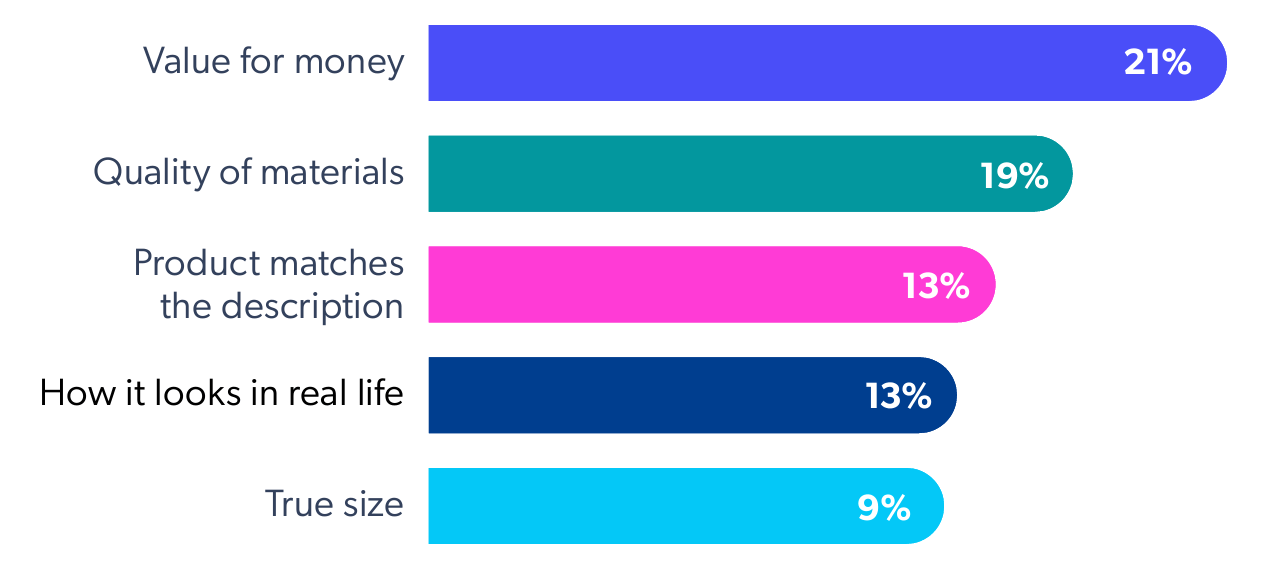February 5, 2024
How much power do product reviews actually hold over consumers’ buying decisions? Far more than you might think. But what does good actually look like? What’s an example of a product review that shoppers want to see?
Product reviews and other forms of user-generated content (UGC) have become the cornerstone of trust and loyalty in the digital marketplace.
- 88% of shoppers use reviews to discover and evaluate products
- 47% say online reviews are an influential source of information, second only to recommendations from family and friends
- Companies that incorporate UGC into their social campaigns see a 50% increase in engagement
- 84% of millennials say UGC affects their purchasing decisions, while almost half of Gen Z customers say social media is their top inspiration for buying a product
But here’s the catch — not all reviews are created equal. What transforms a simple product review into a pivotal decision-making tool for shoppers?
Several things, according to insights from industry professionals we recently surveyed. “A great review isn’t just about a star rating; it’s about validating the quality, setting accurate expectations, discussing performance and functionality, and offering additional tips,” one seasoned product owner told us. “Incorporating sentiment, visual evidence of the product in various contexts, detailed style and design commentary, assessments of comfort and wearability, and, importantly, photographs can turn a good review into a great one.”
We’ll dig into the details customers love to see in good product reviews and guide you through the ins and outs of collecting, compiling, and syndicating this UGC.
To bring these strategies to life, we’ll introduce you to “QualityCouches,” a hypothetical brand we completely made up — but based on real research. By stepping into the shoes of a consumer, you’ll gain a deeper understanding of how strategically curated product reviews can elevate the shopping experience, ensuring your offerings stand out in a crowded market.
The anatomy of a good product review
When reading reviews, shoppers have conscious and unconscious questions that need to be answered. They want to make sure the item matches their expectations. They want to know what other customers think about the product in the short and long term. And they want to get a sense of what the item will be like in real life.
Here’s 13 examples of the specific information they’re looking for in your product reviews.
1. Value and quality assessment
Shoppers are looking for value for money, and review content is where they find it. They want to see information that makes it easier to plunk down their hard-earned cash on a purchase. And value doesn’t just mean price — they want to know the product quality is worth the cost, too. 62% of shoppers are looking for information that validates the item is worth the money and 59% want to confirm it’s of high quality, according to our Shopper Experience Index.

For big purchases like a couch, a good product review example might include information about the quality of the fabric or its stability, and durability of the item. Users want to see that it’s comfortable enough for a long movie night or Netflix binge.
2. Product details
When scanning reviews online, 44% of shoppers are looking for validation that what arrives in the mail will match what appears on your website.
If someone is on the QualityCouches site looking for a new sofa that’s easy to clean and can withstand the wear and tear of a toddler, it’s not enough to see “kid-friendly” or “stain resistant” in a product description.
Here’s a good example of a product review that could turn them into a QualityCouches customer:
“This couch easily stands up to my three kids. It’s really easy to clean. Yesterday, my oldest spilled cranberry juice on the cushions and it came out easily with some warm water. Highly recommend this couch for households with small kids!”
Even if you don’t have kids, you’ll feel more confident about how easy the couch is to clean after reading a product review like that!
3. Usage and user context
It’s not enough to know a product works. Shoppers want to know if a product will work specifically for them. Examples of good product reviews include context about the reviewer, the problems they were trying to solve, and where and how they used the products.
- 71% of shoppers are looking for reviews from people who share their interests, needs, or concerns
- 62% of consumers said they are more likely to trust reviews that include information about the poster’s age, location, or other information as opposed to anonymous reviews
For example, this product review that might resonate with shoppers looking for a dog-friendly couch:
“We are empty nesters with two labs that we treat like our children. Our dogs love to cuddle with us on the couch. They shed a lot and we needed something that was easy to clean. This couch is perfect. The material is great. Their fur doesn’t stick to it. It’s also really easy to wipe off slobber and dirt.”
The more shoppers see themselves in the reviews, the more likely they are to buy the product.
4. Comparisons to expectations
Probably everyone who shops online has been disappointed at one time or another by a product that failed to meet their expectations, leading to higher e-commerce return rates. And no-one wants that. Shoppers want to hear from other shoppers whether your products live up to their promises.
If you’re shopping at QualityCouches, you want to see examples of product reviews that validate the claims made in the product descriptions.
The more real shoppers say a sofa lives up to its promises of comfort and stability, the more confidence a consumer will have about adding the couch to their cart.
5. Style and design commentary
No matter how much effort the QualityCouches team puts into crafting the perfect product description, shoppers will still dig through the reviews to make sure that your definition of “mid-century modern” or “farmhouse industrial” matches their own — 41% of shoppers search for information about what a product looks like in real life when reading reviews
Visual UGC like photos and videos can also appease these shoppers. More on that in a minute!
6. Comfort and wearability
All right, by now shoppers know QualityCouches sells items that look good, but do they feel good? Is the material scratchy? Will it bother their sensitive skin? Will the pillows leave awkward marks on their face if they fall asleep during a boring movie?
A good product review will answer these questions and assure shoppers that the couch is as cozy as it is stylish.
7. Ease of use
Sometimes it’s the big things that make you love (or hate!) a product. But often, it’s the little things.
For anyone who’s ever had to put together furniture, you can empathize with the shoppers on QualityCouches who are looking for feedback on whether the products are easy to assemble. They might also want to know whether the couch is easy to clean, if the cushions are removable, and how easy it is to set up the pullout bed.
8. Long-term impressions or performance and functionality
As every shopper knows, you may love an item when it first arrives. But after a few weeks and months? Not so much.
Consumers are poring through your reviews looking for examples of how your products hold up in the long run. Was the couch still comfortable after six months of use? Did the material fade over time?
Just because a few weeks (or even months) have passed since the shopper made their purchase, that doesn’t mean it’s too late to ask for a review. Hearing what people think about the product in the long term can help build consumer trust and confidence.
9. Pros and cons
Negative reviews happen. But that’s not necessarily a problem. Actually it’s a good thing.
Consumers appreciate learning more about a product’s pros and cons from other shoppers. Negative reviews give shoppers more confidence in the authenticity of your UGC, which helps build trust and transparency.
- 62% of consumers say negative reviews are as important as positive reviews in their decision-making process
- 75% of shoppers say it’s important to read a balance of positive and negative reviews when purchasing to set expectations correctly
- 93% of consumers say they would rather purchase a product with a lot of positive and negative reviews compared to a product with no reviews
Here’s a product review example for QualityCouches that could help a shopper make an informed decision.
“My in-laws spent two weeks sleeping on the pull-out sofa. By the end of the first week, they were pretty uncomfortable. The couch is fine if someone is just spending the night, but I wouldn’t use it for long-term guests. I wish I had bought the Superior Comfort model.”
10. Photographs
Visual UGC like photos and videos makes potential customers even more confident about clicking that “add to cart” button. According to one of the respondents to our product reviews survey, a digital product administrator, “a high-quality review always has photos.”
- 85% of consumers say they turn to visual UGC over branded content when making purchasing decisions
- Over a third of shoppers say reviews with photos are more credible than those without
When reading reviews, 41% of shoppers want to see what a product looks like in real life. Encouraging your customers to share photos and videos of your product in action helps build that trust and confidence.
11. Recommendations and additional tips
Part of the beauty of reviews is that they can provide you and your customers with valuable feedback. Shoppers can learn how to use a product to its full potential, while brands and retailers can find ways to improve and transform the shopping experience — and drive growth. According to our research, the main ways brands and retailers use UGC are:
- 80% improve the shopper experience
- 78% increase conversions
- 76% improve marketing messaging
- 74% improve product pages
- 68% improve SEO
- 67% reduce returns
Take this QualityCouches product review example:
“The couch is great but the armrests are really narrow. Make sure you have a side table nearby to put your drink, snacks, and remote on.”
This gives shoppers valuable feedback from other customers about where to place the couch in their home. It also gives the brand some interesting insight to bring back to its product team.
12. Star ratings and summaries
As much as people love in-depth UGC, sometimes they don’t have time to read a bunch of reviews. Star ratings and review summaries help shoppers quickly understand how many people gave feedback about the product, what the overall star rating is, as well as a few pros and cons to consider.
Here’s an example of a product review summary.

Note the immediate average star rating and percentage of recommendations highlighted in bold, the breakdown of product criteria, pros and cons, and a trust signal to confirm review authenticity. Displaying review highlights in a simple manner speeds up the reviewing process which leads to faster (and more) purchases.
13. Recency of reviews
Real talk: A ton of great reviews, photos, and star ratings from 2020 won’t appease today’s shoppers. They want to know what recent customers thought about their purchase.
61% of consumers say recent reviews — those submitted in the past three months — are more reliable than older ones.
How to get more authentic and effective reviews
Ready to up your product review quality? Here are three tips to keep in mind.
1. Make it easy for customers to leave reviews
Shoppers like sharing their opinions. Nearly 70% of shoppers are willing to provide feedback when asked. The secret to collecting more helpful product reviews is to make it easy for customers to submit feedback. Often, all you need to do is send a quick email or two.
Requesting feedback via email can increase product reviews by up to 9x. Sending a follow-up review request email can boost review volume by 50%.
Struggling to get more reviews on your PDPs? See our guide to requesting reviews from your customers.
2. Ask questions that encourage specific feedback
Now that you know what shoppers are looking for in your product reviews, you know what questions to ask. For example, QualityCouches might ask questions like:
- How would you rate the item’s quality?
- Did our product meet your expectations?
- How would you describe the style?
- Tell us about yourself and how you use the product
- Do you have any photos or videos of the couch in your home?
3. Give shoppers product review examples
In addition to requesting specific information, you can also include examples of product reviews that answer the questions.
This makes it easier for customers to provide the exact information you — and other shoppers — are looking for.
Ready to make a bigger impact?
Customer reviews are more than just helpful — they’re game-changers. They can boost your conversion rates, keep shoppers on your site longer, and ramp up your engagement metrics. But let’s be real: Managing these reviews can be tricky, especially for small teams.
That’s where review management tools come in. They’re designed for efficiency, helping even the smallest teams compete and excel. Plus, they give you a clear view of your return on investment for your UGC efforts.
Now’s the time to boost your digital presence with honest, persuasive user reviews. Don’t let operational challenges hold you back. Our solutions can simplify your processes and lift your brand to new heights. Hairhouse Australia implemented our Ratings & Reviews tools to provide shoppers with authentic UGC that inspires purchases, and saw a 35% lift in conversion rate and a 15% increase in average order value on pages with Ratings & Reviews vs. pages without.
You can learn more about our Ratings & Reviews tools here. Or get in touch with our customer success team today to see what’s possible. Together, we can revolutionize your approach to UGC, building trust, loyalty, and impressive growth.
Get started









